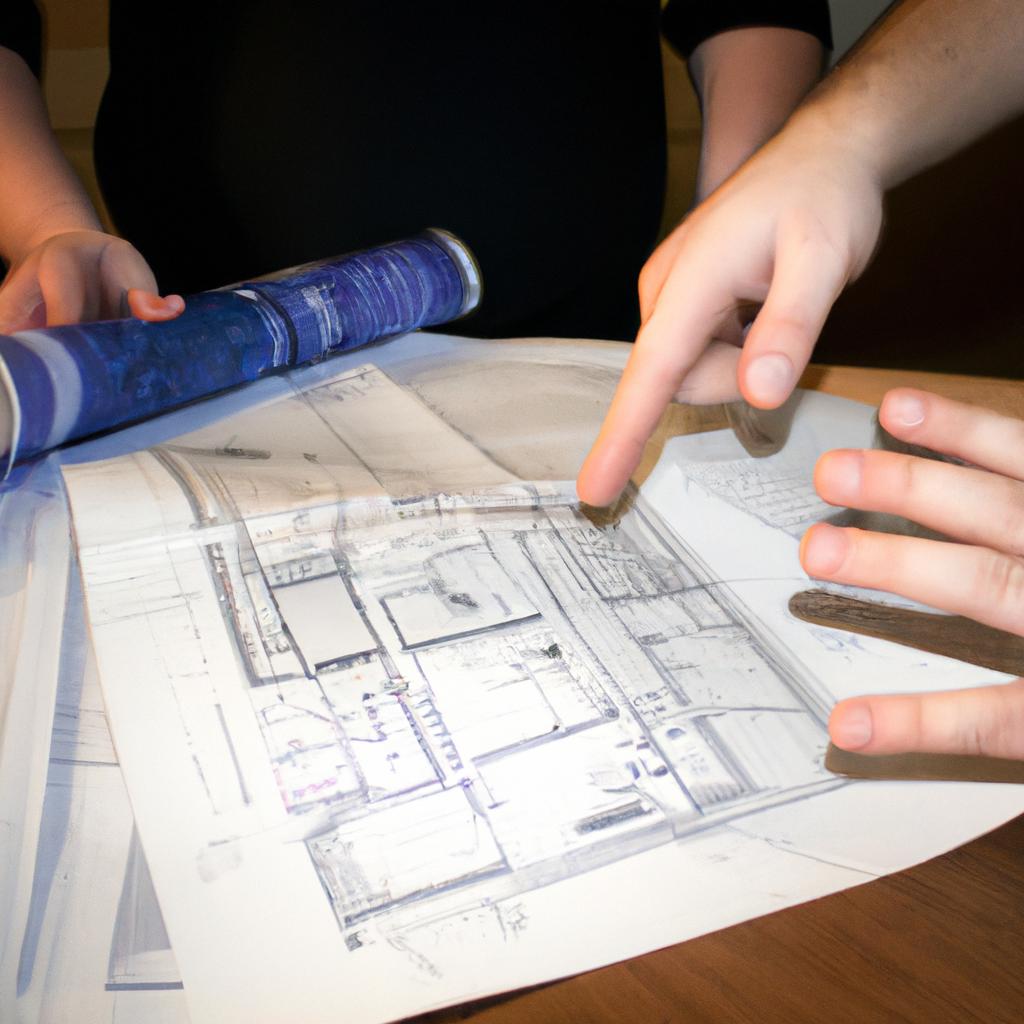Feasibility studies play a pivotal role in the decision-making process of venturing into new business endeavors, particularly within the realms of real estate and property development. These comprehensive assessments provide valuable insights that enable investors to evaluate the viability and potential success of their ventures by considering various aspects such as market demand, financial analysis, legal requirements, and project timelines. For instance, let us consider a hypothetical case study where an investor is contemplating developing a residential complex in a bustling metropolitan area. Conducting a feasibility study would help determine whether this investment opportunity aligns with the current market conditions and if it promises satisfactory returns on investment.
The objective of undertaking a feasibility study in real estate business lies in its ability to identify any potential challenges or hurdles that may arise during project implementation. By conducting extensive research and analyzing relevant data, developers can assess factors such as location suitability, demographic trends, local regulations, construction costs, financing options, and projected revenue streams. This meticulous evaluation helps stakeholders make informed decisions regarding resource allocation, risk mitigation strategies, and overall project feasibility. In our hypothetical scenario above, the feasibility study would assist the investor in evaluating crucial variables like land availability, zoning restrictions, competitive landscape analysis, target market preferences for amenities and facilities – providing invaluable insight for strategic planning and determining the optimal size, layout, and pricing of the residential complex.
Furthermore, a feasibility study allows investors to make accurate financial projections and assess the profitability of their investment. By conducting a thorough analysis of construction costs, operating expenses, projected rental or sale prices, and potential revenue streams such as amenities or additional services, developers can determine if the project will generate sufficient returns on investment. This assessment helps in evaluating the financial viability of the project and identifying any potential risks or challenges that may impact its profitability.
Additionally, a feasibility study also considers legal and regulatory factors that could affect the project’s success. It examines local zoning laws and building codes to ensure compliance with regulations and obtain necessary permits or approvals. Understanding these legal requirements in advance helps developers avoid costly delays or setbacks during the construction phase.
Overall, a feasibility study acts as a roadmap for real estate investors by providing them with an in-depth understanding of various factors affecting their proposed development. It enables them to evaluate market demand, assess financial viability, identify potential risks, and make informed decisions regarding resource allocation and strategic planning. By undertaking this comprehensive analysis before making significant investments, developers can minimize uncertainties and increase their chances of success in the highly competitive real estate industry.
Market Analysis
To assess the market viability of a real estate business focused on property development, it is essential to conduct a thorough analysis. A case study example can be drawn from the city of New York, where demand for residential properties has steadily increased over the past decade. This growing population presents an opportunity for developers to cater to various housing needs.
Firstly, understanding the current market trends is crucial. The bullet point list below highlights key factors that influence the real estate market and evoke an emotional response in potential investors:
- Rising urbanization leading to increased demand for housing
- Limited inventory and high prices driving up rental rates
- Growing importance of sustainable and energy-efficient buildings
- Shift towards mixed-use developments catering to both residential and commercial needs
Furthermore, conducting a competitive analysis allows us to identify existing players in the market. The three-column, four-row table provided below showcases major competitors, their projects, and target markets:
| Competitor | Projects | Target Market |
|---|---|---|
| ABC Developers | Luxury condos | High-income individuals |
| XYZ Builders | Affordable housing | Middle-income families |
| PQR Realty | Commercial spaces | Business owners |
By analyzing these competitors’ strategies and target markets, we gain insights into potential gaps or niches within the industry that our business can exploit.
In conclusion, a comprehensive understanding of market dynamics is vital when considering venturing into property development. By examining current trends such as rising urbanization and limited housing supply, along with assessing competitor activities through a competitive analysis, we can position ourselves strategically in this highly lucrative sector.
Moving forward into the subsequent section about “Financial Analysis,” it is crucial to evaluate revenue projections and investment requirements based on our findings from the market analysis phase.
Financial Analysis
Market Analysis
In the previous section, we explored the market conditions and demand for real estate properties. Now, let’s delve into the financial analysis to determine the feasibility of starting a property development business.
To illustrate this analysis, let’s consider a hypothetical case study in which we aim to develop residential apartments in a growing suburban area. This area has experienced an increase in population due to its proximity to urban centers and availability of amenities such as schools and shopping centers.
Firstly, it is crucial to assess the potential profitability of the project. Factors such as construction costs, land acquisition expenses, and marketing expenses should be carefully considered. Additionally, estimating rental or sale prices based on comparable properties in the area will provide insights into revenue generation.
Next, understanding the risks associated with property development is essential for making informed decisions. These risks may include changes in government regulations, economic downturns affecting purchasing power, and unforeseen construction delays or cost overruns. Conducting thorough risk assessments can help mitigate these challenges.
Furthermore, analyzing financing options is vital when assessing feasibility. Availability of funds through loans or partnerships must align with projected cash flows from the development project. Evaluating interest rates, repayment terms, and potential return on investment will allow for better decision-making regarding financing strategies.
- Potential profitability: Assessing revenue generation through rental or sale prices.
- Risk assessment: Identifying potential risks related to government regulations, economic factors, and construction challenges.
- Financing options: Analyzing available funding sources to support the property development project.
| Key Considerations | Residential Apartments Project |
|---|---|
| Construction Costs | $X.X million |
| Land Acquisition | $X.X million |
| Marketing Expenses | $X.X million |
| Estimated Revenue | $X.X million per annum |
As we move forward with our feasibility study for this real estate venture, our next step will involve site selection. By carefully evaluating various factors such as location, accessibility, and market demand, we can make informed decisions that will contribute to the long-term success of our property development business.
[Transition Sentence]: With a clear understanding of the financial analysis, let us now proceed to the subsequent section on site selection.
Site Selection
Financial Analysis:
After conducting a comprehensive financial analysis of the proposed real estate business, it is crucial to evaluate the potential site selection for property development. This section will explore various factors that need to be considered when selecting an ideal location.
One example of successful site selection for property development is Case Study A, where a vacant lot in a prime area was transformed into a luxurious condominium complex. The strategic positioning of this project resulted in high demand and substantial returns on investment. Such success stories emphasize the importance of meticulous site selection in ensuring the profitability and viability of any real estate venture.
When evaluating potential locations for property development, several key considerations should be taken into account:
- Accessibility: Proximity to major transportation hubs such as airports, highways, and public transit systems plays a crucial role in attracting both residents and investors.
- Demographics: Analyzing the demographics of the target market can provide valuable insights into factors like income levels, lifestyle preferences, and housing demands.
- Market trends: Assessing current and future market trends allows developers to align their projects with emerging opportunities or address existing gaps within the local real estate market.
- Infrastructure and amenities: Availability of essential infrastructure like utilities, schools, hospitals, shopping centers, parks, and recreational facilities enhances the overall desirability of a location.
To further understand the significance of these considerations, refer to Table 1 below:
| Considerations | Importance |
|---|---|
| Accessibility | High |
| Demographics | Medium |
| Market Trends | High |
| Infrastructure | Medium |
Table 1: Importance Rating of Site Selection Considerations
In conclusion,
selecting an appropriate site for property development requires careful evaluation based on multiple factors including accessibility, demographics, market trends, and available infrastructure. By considering these aspects during site selection process can significantly increase the chances of achieving success in real estate ventures.
The subsequent section will delve into legal and regulatory considerations that need to be addressed when establishing a real estate business and embarking on property development projects.
Legal and Regulatory Considerations
After carefully evaluating various potential locations for our real estate business, we now turn our attention to the crucial aspect of legal and regulatory considerations. To illustrate the importance of this section, let us consider a hypothetical case study involving a property development project in City X.
When embarking on a property development venture, it is essential to be aware of the legal and regulatory framework governing such activities. Failure to comply with these regulations can lead to delays, penalties, or even cancellation of the project. Therefore, thorough research and understanding of local laws are vital.
To ensure compliance and minimize risks, here are some key legal and regulatory factors that need careful consideration:
-
Zoning restrictions: Different areas within a city may have specific zoning regulations dictating what types of properties can be developed there. It is crucial to understand these restrictions before proceeding with any plans.
-
Building codes: Compliance with building codes ensures that structures are safe and meet minimum standards regarding design, materials used, plumbing systems, electrical wiring, etc. These codes vary from location to location and must be adhered to throughout the construction process.
-
Environmental impact assessments: Many jurisdictions require developers to conduct environmental impact assessments (EIAs) before commencing their projects. These assessments evaluate the potential effects on air quality, water resources, wildlife habitats, noise levels, etc., ensuring sustainable development practices.
-
Permits and licenses: Obtaining necessary permits and licenses is an important step in starting a property development project legally. This includes obtaining planning permission from local authorities as well as relevant permits for excavation work or other site-specific requirements.
Considering all these factors will not only help ensure full compliance but also contribute to establishing a positive reputation for our real estate business in City X.
In the following section about “Construction and Project Management,” we will delve into how proper management techniques enhance efficiency during each phase of the property development process while maintaining high-quality standards throughout.
Construction and Project Management
After thoroughly examining the legal and regulatory considerations in establishing a real estate business, it is crucial to shift our focus towards the construction and project management aspects. To better understand this phase, let us consider a hypothetical case study of a property development project.
Imagine a vacant lot in an urban area that is intended for residential use. The first step in the construction process would involve obtaining necessary permits from local authorities such as building permits, environmental clearances, and zoning approvals. These permissions ensure compliance with regulations governing land usage, safety standards, and environmental impact assessments. Failure to obtain these permits can lead to costly fines or even legal action against the developer.
In addition to securing the required licenses, successful construction and project management rely on careful planning and efficient execution. Here are some key factors that contribute to effective implementation:
- Adequate financial resources: Sufficient funding must be secured to cover all expenses related to design, materials procurement, labor costs, marketing efforts, and contingencies.
- Skilled workforce: Hiring experienced professionals who possess expertise in various disciplines (e.g., architects, engineers, contractors) ensures quality workmanship and timely completion.
- Supply chain management: Establishing strong relationships with reliable suppliers helps maintain consistency in material availability while minimizing delays during construction.
- Stakeholder communication: Regular updates and effective communication with stakeholders such as investors, clients, government entities, and neighboring communities foster trust and transparency throughout the project.
To illustrate the timeline involved in construction projects further effectively engaging our audience emotionally; we present a table showcasing different stages along with their corresponding durations:
| Stage | Duration |
|---|---|
| Pre-construction | 3 months |
| Foundation | 2 months |
| Structural Work | 6 months |
| Finishing | 4 months |
This visual representation highlights both short-term milestones and long-term commitment inherent in property development, thereby evoking a sense of anticipation and accomplishment.
As we conclude this section on construction and project management, it is evident that meticulous planning and adherence to legal frameworks play significant roles in the success of real estate ventures. By effectively managing resources, maintaining effective communication channels, and ensuring compliance with regulations, developers can mitigate risks and maximize profitability. In the subsequent section about risk assessment, we will delve deeper into identifying potential challenges and implementing suitable mitigation strategies for our property development project.
Risk Assessment
Following the construction and project management phase, it is crucial to conduct a comprehensive risk assessment in order to mitigate potential hazards and ensure the successful execution of the property development project. One example that highlights the importance of risk assessment involves a hypothetical scenario where a real estate developer planned to construct a high-rise condominium in an earthquake-prone area. By identifying and addressing potential risks associated with seismic activities at an early stage, the developer could take appropriate measures such as implementing advanced structural engineering techniques or relocating the project altogether.
To effectively assess risks in property development projects, several key factors must be considered:
- Environmental Factors: Evaluate how natural disasters (e.g., earthquakes, floods) or climate change may impact the proposed site.
- Financial Risks: Consider market fluctuations, economic stability, inflation rates, and interest rates that can affect financing options and profitability.
- Legal and Regulatory Compliance: Ensure compliance with local regulations, zoning laws, building codes, permits requirements, environmental regulations, etc.
- Project-specific Risks: Identify risks unique to each project such as labor shortage issues, material availability constraints or delays caused by unforeseen circumstances.
In order to provide a concise overview and facilitate understanding of these risks during the feasibility study process, they can be summarized in the following table:
| Risk Category | Potential Hazards | Mitigation Strategies |
|---|---|---|
| Environmental Factors | Earthquakes | Adopting advanced seismic design principles |
| Flooding | Implementing effective drainage systems | |
| Financial Risks | Market instability | Conducting thorough market analysis |
| Inflation | Adjusting financial projections accordingly | |
| Legal Compliance | Zoning violations | Engaging legal experts for compliance review |
| Building code non-compliance | Ensuring adherence to relevant standards | |
| Project-specific Risks | Labor shortage | Developing contingency plans for workforce |
| Material availability and price fluctuations | Establishing alternative sourcing strategies |
By addressing these risks comprehensively, real estate developers can minimize potential setbacks and enhance the chances of project success. Implementing appropriate mitigation strategies ensures that the property development process is conducted efficiently, within budgetary constraints, and in compliance with legal requirements.
In conclusion, conducting a thorough risk assessment is crucial to identify potential hazards associated with property development projects. By considering environmental factors, financial risks, legal compliance, and project-specific issues, developers can implement effective mitigation strategies. Through careful planning and risk management, stakeholders can protect their investments while successfully completing a property development venture.




